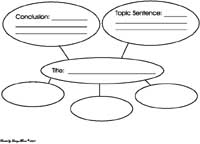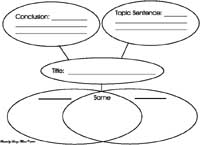 From Here to There
From Here to There
by Ginny Hoover
Writing in the Primary Grades
When preparing to teach writing in the primary grades, consider these . . .
- Six Traits--the traits that are present in quality writing,
- Writing Process--the steps from brainstorming to publishing
- Strategies of Approach--shared, interactive, independent, and guided
Six Traits Writing Model/The Writing Process
The Six Traits Writing Model and the Writing Process should be taught together. To teach each separately and not teach how they are related causes a breakdown in achieving quality writing. The Six Traits are Ideas and Content, Organization, Voice, Word Choice, Sentence Fluency, and Conventions.
Ideas and Content and Organization fit well with brainstorming and preparations for creating a rough draft. After brainstorming, quality ideas are selected--this is when to stress Ideas and Content. Interestingly enough, organization is part of both the writing process and the writing model! They are a natural fit. I use the same graphic organizer format for teaching writing. Then, no matter what aspect of writing I am teaching, the instruction time isn't lessened by needless questions on what goes where on some cute, but confusing graphic organizer. Figure 1 is a good paragraph organizer for narrative and expository. Figure 2 is a graphic organizer for compare/contrast. Notice the similarities. Basic knowledge of the organizer is easily transferred.

figure 1 (click image for printable pdf copy)

figure 2 (click image for printable pdf copy)
The remaining traits plug in well in the revision/editing steps of the Writing Process. When lessons are taught regarding these qualities of writing, revision is a natural place to consider them. For instance, in revision, the writer may discover that Sentence Fluency is weak. Then he/she can insert transitions and/or improve previously selected transitions. Also the writer should check for Convention errors and awkward phrasing that detract from fluency. One way I have my students find Sentence Fluency errors is to speed read, and while doing so, highlight any section that doesn't read easily--then once rough areas are located and the trouble identified, corrections can be made. My best recommendation for improving Word Choice is learning to use a simple first thesaurus divided by parts of speech (nouns are in one place, a section for verbs, etc.). Voice and Word Choice are closely related. The strongest Voice is expressed with carefully selected words…work first on verbs, next describing words, and then nouns. Conventions have been part of the writing program for years, and there is an abundance of material. The key to success with lessons on Conventions is immediate application. Teach application during the editing process.
Strategies of Approach
There are several good teaching strategies, and a combination of the four to be discussed is desirable. Each strategy has a different level of dependence/independence.
Shared writing places the teacher in maximum control. During shared writing, the teacher acts as a scribe and decides what to record. The students share suggestions. This strategy is particularly successful when student writing skills are undeveloped, and when the goal is to have students focus on ideas, not how to record them.
Interactive writing is a step up from shared writing. The teacher still has control over what is written. However in this strategy, the teacher shares the writing tool or keyboard at times with the students. The students have some responsibility for recording information, but focus is still mainly on the students' ideas.
Independent writing allows the students to exhibit personal writing skills. With this strategy, students record their ideas by themselves. It is the strategy used for the assessment of writing.
Guided writing/Writer's Workshop is the strategy involving interaction between a student or a small group of students and the teacher. Guided writing includes mini lessons that address writing needs. Also, it includes individual conferencing providing an opportunity for the teacher to assist the student in recognizing strengths and weaknesses of a writing piece. In addition, a plan for correcting errors can be made.
Putting it All Together
The Writing Process provides the framework to produce the writing. The Six Traits Writing Model helps students recognize the qualities of good writing. The strategies provide opportunities for practicing writing with different levels of guidance. Together, they can be the core of a good writing program.
Visit Ginny's Educational WebPages!
| 
